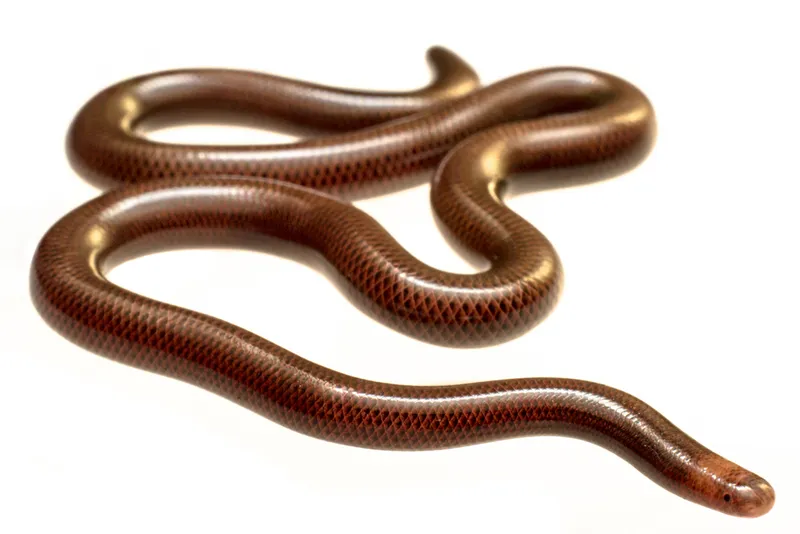Blind Snakes - The smallest snakes in the world
In Brazil, there are about 430 species of snakes1, of different shapes and sizes, venomous or not, from those that like aquatic environments to those that live in dry lands or high up in trees. In the midst of such diversity, there is also a group of small snakes that have adapted to living underground - they are the blind snakes.
Blind snakes (Scolecophidia) are a group of nocturnal, non-venomous snakes with fossorial habits, living underground, on tree trunks or in burlap. They are the smallest snakes in the world, ranging from 4 inches to 3 feets in length.
They are called blind snakes because of their small, vestigial eyes, which are located under semitransparent scales that protect them underground but reduce their vision. Therefore, blind snakes can only see changes in light and orient themselves mainly by sniffing with their tongues the chemical signals left by their prey, just like other snakes.

All blind snakes eat small prey such as termites, ants, their larvae and eggs, but they may occasionally feed on other invertebrates. Some species can live quietly in ant nests due to their ability to produce a chemical that protects them from ant attack.
Because of their diet, blind snakes have few to no teeth, and although most are small, they are large compared to their prey. As a result, they do not need to and cannot expand their jaws when feeding as larger snake species do.
Blind snakes have a round, stout head and tail that help them propel their bodies underground. Although all species live underground, some have been seen in trees after following a termite trail2.
Another feature common to most species is a small thorn at the tip of the tail that can be used for defense - however, they are not dangerous to humans and their bite causes only a slight tingling, depending on the species. Other methods of defense include vomiting up their last meal and emitting an unpleasant odor3.
The families of blind snakes

Five families4 of blind snakes are known, three of which live in Brazil:
The first family of blind snakes found in Brazil is commonly called Dawn Blind Snakes (Anomalepididae), has about 18 species, seven of which are found in Brazil, they are also the blind snakes with the largest geographic distribution in the Americas5 Most blind snakes in these families measure between 15 and 30 cm (6 and 11 inches), but can reach up to 40 cm (16 inches)2.
The second family has the common name Threadsnakes (Leptotyphlopidae), has about 57 species, 16 of which are found in Brazil6 Snakes in this family reach a maximum of 46 cm (18 inches), but usually measure 15 to 25 cm (6 and 10 inches). They are found in the Americas, the Middle East, and Africa. This family is home to the world’s smallest snake (Leptotyphlops carlae), about 10 cm (4 inches) long, endemic to the island of Barbados2.
The third family (Typhlopidae), named the Typical Blind Snakes, is the most numerous with about 230 species. These snakes are usually small, between 14 and 18 cm (5 and 7 inches) long, and are found in tropical regions all over the world,2 but in Brazil only the Reticulated Worm Snake (Amerotyphlops reticulatus) can be found - from the Amazon to northern São Paulo7.
Blind snakes are difficult to find, so they have not been fully studied. In fact, it is not even known for sure how many of these animals exist, and many other details of their biology and population size remain unknown.
Understanding more about these animals is essential if we are to protect them, because all animals have some impact on the environment in which they live. For example, bat snakes help control the number of termites, ants, and other insects that can be harmful to humans. Blind snakes, on the other hand, are harmless and beneficial animals, so having them around is a good sign.
References:
-
Costa, Henrique C., Guedes, Thaís B., & Bérnils, Renato Silveira. (2022). Lista de Répteis do Brasil: padrões e tendências. https://doi.org/10.5281/zenodo.5838950 ↩︎
-
Laurie J. Vitt and Janalee P. Caldwell. Sam Noble Museum and Biology Department - University of Oklahoma. Herpetology: An Introductory Biology of Amphibians and Reptiles (Fourth ed.). Academic Press. pp. 597–603. ISBN: 978-0-12-386919-7 ↩︎
